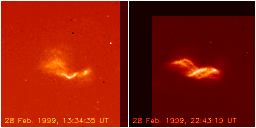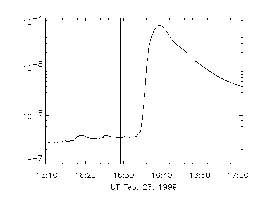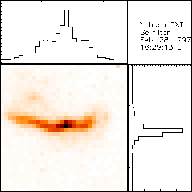

This difference image shows bright large-scale loops that have formed after the eruption (white), and the thin, sigmoid active-region structure that disappeared during the eruption (dark). We can't easily see a bipolar "transient coronal hole" dimmings in this event, but other indicators of eruption are certainly there, not least of which is the LASCO CME list maintained on the Web. Simon Plunkett's listing shows "17:54 NW Arcade with core. M-flare in EIT" about as expected.
The sigmoid character of this region is interesting, because its visibility (not the helicity itself) comes and goes during the disk passage. Regard the images below, spaced half a day apart on either side of the big flare:

These are both Be images, so they show the hottest material that SXT can see. The sigmoidalicity is clear in both of them, but shows up differently. This suggest what one would expect, namely that the sigmoid character - a creature of the large-scale field pattern - has a long lifetime, but its illumination comes and goes following the mysterious rules of loop excitation.
Incidentally, the configuration on the right is unusual and beautiful. Click to enlarge. The images are 5 arc min on a side, and the dark lanes result from the coalignment process.
 |
 |
The GOES time profile above has the SXT beryllium-filter PFI times superposed, with the solid line showing the time of the specific image shown with X- and Y- brightness profiles through the brightest pixel. GOES shows no trace of the "precursor," if that's what this is. According to one standard scenario for the development of eruptive events, "tether cutting" must occur below the site of the eventual arcade development, allowing the twisted flux rope to escape upwards and establish the configuration for arcade development in the flare decay phase.
So, we speculate... are these tiny brightenings the individual tethers being cut, each releasing a bit of magnetic energy via reconnection? Or, since reputable theorists may take a dim view of the credibility of this scenario, are these brightenings just a coincidence resulting from the fact that emerging magnetic flux does not emerge randomly, but in a manner highly correlated both in space and time? A sophisticated statistical study is needed.